The crops are harvested, the silos and elevators are full and you need to begin the process of freight shipping grain soon to capitalize the investment of time and money you’ve already put into it. But where do you even start and what must be worried about in order to do it the correct way?
In truth, freight shipping grain — which is the movement of these crops either into storage or to the mills where they’ll be processed — isn’t hard as long as you follow the Food and Drug Administration’s (FDA) guidelines, do your best to make sure the moisture content is right and learn about the most efficient way to ship the grain.
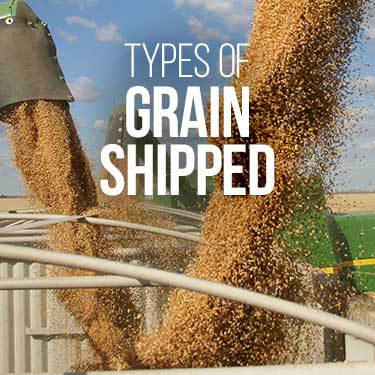
Grains in their various forms are a staple of diets in every country in the world, including the United States. So there is a large overall demand for them as food and even being converted into ethanol to be used as fuel when mixed with gasoline.
Grains can be consumed in their original form or made into another food product such as popular choices like pasta, bread and cereal. Grains are renowned for their ability to be stored for a long time, made into flour and have oil extracted from them. These factors lend to their incredible versatility and really open up a world market for them.
While this is not a complete list, the following are among the most common grains that are consumed:
A couple of notes about this list — kernels of corn (think popcorn kernels) are considered a grain while an entire cob of corn is a vegetable. Also wild rice is actually aquatic grass and different from regular rice, which is a grain. However, wild rice is still classified as a grain both food wise and how it is handled during transport. Also legumes, which include beans, are sometimes considered a grain because they are the seed of a plant. However, beans are really classified as a high protein vegetable.
Grains are used as food for both humans and animals, including livestock. So the need to have grain shipped is big for humans and even the other foods humans consume such as dairy products and meat.
As far as actual production, corn is by far the most produced grain in the world at 1.1 billion metric tons. In fact, it was easily America’s largest cash crop with an estimated $49.4 billion in 2019, which accounted for about a quarter of the $193.7 billion generated by all U.S. cash crops. Among grains, wheat was second with $8.7 billion. The U.S. — as a major grain producer — exports grains to many different countries and is a both a top 3 producer and exporter in the world.
With some crops, more is being done with less. Just look at America’s wheat output. Since the 1990s, production of this crop has stayed roughly the same while being planted on about 80 percent of its original acreage. This shows that American farmers are becoming more efficient in their ability to produce wheat.
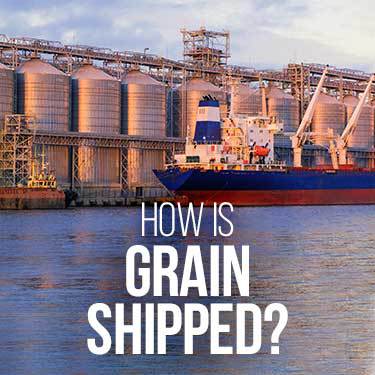
This is one of the more important aspects of the entire grains trade process. Farmers have spent months growing grains and want to maximize their return on this lengthy investment. Currently, there are several different ways to have grains transported.
Let’s first look at how it would be loaded onto a freight truck. Oftentimes, grain is not loaded fresh from the field onto the back of an 18-wheeler to be immediately taken to a company that makes bread, for instance. Instead, the grain is loaded into a grain elevator which is used to stockpile products that have already been earmarked for sale or are stored for future sale.
A grain elevator allows farmers to store their crops and, in turn, mass produce them. These grain elevators are generally built near railways or bodies of water so that trains or ships can be used to transport them. Trucks are also a popular method of transportation to move grain, so the grain elevator is set up to accommodate any sort of grain hauling.
Increasingly, it’s common for many products — including grain — to utilize intermodal transport to complete grain shipments. This type of transportation refers to using two or more different kinds of transport, like using rail and truck to move one shipment of wheat. Domestically in the United States, rail and truck are predominantly used, with ocean barge accounting for a very small percentage.
Conversely, when grains are exported, ocean shipping as a method for the movement of grain increases greatly, especially for overseas journeys. Overall, the different methods of transportation compete with one another but in today’s fast-paced world where efficiency and low costs are at the top of the list, they also end up complementing one another.
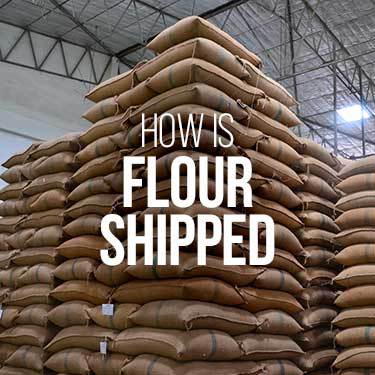
Thinking about bread, cakes, pastas and pastries makes some people’s stomachs dance with delight. But to make these often delicious goods, one has to start with a very basic ingredient: flour. Flour is any type of grain that is grinded up into a fine powder. This powder is then used to bake bread, form spaghetti noodles or even some kinds of chips. While most think of wheat flour right away, some other popular grains like corn or rye are also milled into it.
Flour is usually transported in gunny bags, which are sacks made of natural fibers that can hold up to 110 pounds. Alternatively, they are sometimes stored in plastic bags (made out of polythene) that are then put inside cotton bags. This last part is done because cotton is a great material for absorbing water and offers an added level of protection.
Since the grains are no longer in their original form, they are more susceptible to the elements and need very specific conditions surrounding its shipment. Flour needs to be kept absolutely dry, with no liquids coming into contact with it. For this reason, it can’t be shipped alongside something like vegetable oil or bottled water. Flour will also absorb any odors it comes into proximity with, so that is a consideration as well. Just like any type of grain, the truck it’s shipped in should be completely clean as any remnants from previous deliveries could affect the flour.
it is often a sound idea to use a refrigerated truck. This is so the temperature and humidity levels can be carefully controlled. By setting certain controls to modify the moisture, humidity and heat, you can ensure that your flour won’t show up to its destination in an unsuitable state. When working with a great freight company, you can directly ask that your flour freight is placed in a climate-controlled method of transportation. The freight company should have it available and be able to competently handle your ground-up grains.
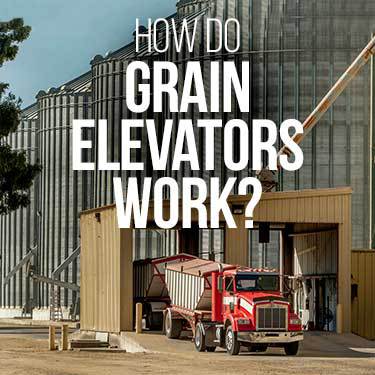
Touched upon briefly in an earlier section, exploring in greater depth how grain elevators factor into the shipment of your crops is good knowledge to have since trucks will unload and load up from them. First of all, these are enormous structures where grains are brought to after harvest and used as temporary storage. Once at the grain elevator, the crops are dried and then put away until it’s time for them to be transported to a refinery or mill.
Farmers will initially store grain in their own barns, but will move their grains to the elevators once a sale price is locked in. This allows farmers to keep growing and harvesting crops while the previous grains already harvested can be prepared and/or stored for sale.
While that describes what a grain elevator does, that doesn’t necessarily explain how the elevator itself functions in order for this to happen. After the giant combines harvest grain, it is placed right into a truck or a grain cart for the grain to be brought directly to the elevator. Once the cart or truck reaches the elevator, it is placed on a scale in order to be weighed. After that occurs, a sample of the grain is taken to make sure it is clean and free of any contaminants.
During this portion, the moisture content of the grain is checked. This is a crucial part of the process for the owner of the grain since it can have financial implications. To be able to store grain, the target to hit for the moisture content is about 15 percent. This is important because if the grain has a higher content, it can more easily become moldy. If the moisture content is below 15 percent, then the grain will be too dry and be of a lower quality.
To put this in further perspective, if wheat has a moisture content of 17 to 18 percent, it is considered to be wet. So there is truly a fine line between grain being “wet” or “dry”.
This is also where the functionality of the grain elevator comes into play. Depending on if the moisture level is too high or too low, it can be dried out or have water added to raise or lower the level. The financial implications enter because the farmer will have to pay to have the grain either dried out or have moisture added before it can go into a silo.
The grain will then transfer from the truck or cart onto the work floor. This part of the grain elevator is an open, grate-like piece of the floor that allows grain to go below onto a conveyor belt. From there, buckets will scoop up the grain and then those buckets will be taken to the top of the silo to be stored.
Once the grain is processed through the elevator, the farmer receives a weight ticket. This contains a bunch of information such as the weight of the grain, the type and quality of the grain and the date of delivery. It also indicates whether the grain will be stored or if it’s already been marked for sale.
If the grain was just left growing in the field until it had a buyer, it is being left susceptible to pests such as birds, rodents and insects while also being left to potentially become moldy if there is too much moisture. The grain elevator allows the grain to be appropriately stored and also monitored to ensure it stays in optimal condition.
Storing grain is a double-edged sword though. There are costs incurred by the farmer to store the grain and also associated with keeping the grain in its best state possible. So a farmer will have to decide if selling at a lower price will be a better move or if — even with the costs of grain storage — waiting until a later date can prove to be more lucrative if the farmer thinks the market price for his grain will go up.
Once the grain is sold and ready for shipment, it will be dispersed back into a truck, rail car or ship. The vehicle of choice for transport will be empty and go back on a scale. Once that weight is recorded, the vehicle moves over to the grain elevator, where spouts will allow the grain to be released from the structure and into the method of transport. The vehicle will be weighed once again to determine how much grain has been loaded.
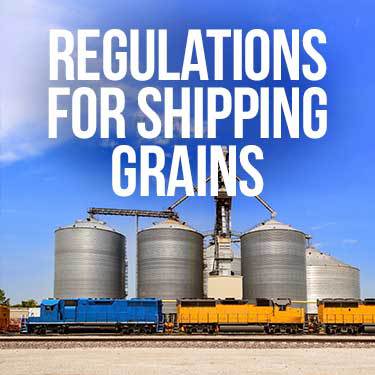
The FDA has stringent rules for any food that humans consume and has encapsulated those in the Food Safety Modernization Act of 2011 (FSMA). This act encompasses the entire supply chain for every kind of food, from growth and harvesting to packaging, storage and transportation.
Much of the FSMA is based on preventative actions being taken in the form of good practices. It is more efficient to make sure the grain is properly handled and processed along the line than trying to mitigate an issue down the line. Or worse yet, make an error that renders the grains unsuitable for human consumption where it must be disposed of.
It is important that the distinction between grain earmarked for human consumption and that for animals are different. While both have regulations regarding them, the ones overseeing grain for animal feed or pet food are not nearly as comprehensive since they don’t need to be.
The facilities and method of transport both have to be clean and absent of pests or contaminants. In fact, loads should remain covered and also free of excess moisture. As previously stated, too high of a moisture content can encourage mold growth. However, it can also attract pests looking for a free meal.
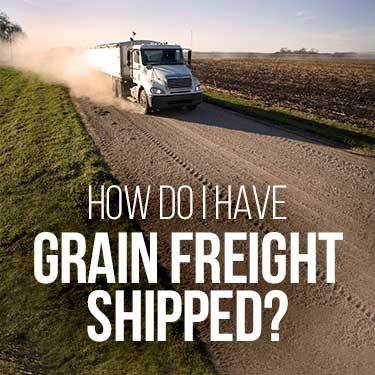
While there are myriad ways that grain can be transported, let’s focus on one of the more popular options for domestic trips — truck freight shipping. Among domestic journeys hauling grain within the United States, the only method more popular is rail. Yet unless there are train tracks connecting the beginning and end of the route, you’ll need a truck for at least part of the hauling.
Going further, it might be more time efficient and a better value to use a truck. Instead of being one or more cars on a train that probably has other freight attached to it, you get the peace of mind that only your freight is in the truck and it’s going straight to its destination without any stops to accommodate other shippers along the way. While it is certainly not a rule of thumb, trucks are thought to be the top option domestically for freight shipping grain on journeys of 500 miles or less — but they are still an excellent option for longer trips too.
Now let’s look at what will happen if you choose to ship via truck. If grain is sent as dry bulk cargo, which is likely when going to a mill for further refining, it will be received at the grain elevator into the back of an 18-wheeler that has a long dump truck-like bed attached to it. This is for easy loading and unloading alike, with the ability to be covered as well during transport.
On the other hand, if the grain is already bagged or put in containers and being shipped to an end customer, a regular enclosed 18-wheeler will do the job nicely. Overall, it will make a big difference on the logistics company you choose to move your grain. Employing an experienced company that has a good track record of expertly shipping grains and shows an ability to work with you and for you are huge pluses for your operation.
One thing to be aware of as you ship grain is the possibility that some types are prone to spontaneous combustion. Corn is most affected by this phenomenon inside silos during storage but it can also happen with bulk cargo shipments. The key is to make sure the grain, whatever type it is, is properly aerated so that the grains of corn in the middle don’t overheat and catch on fire.
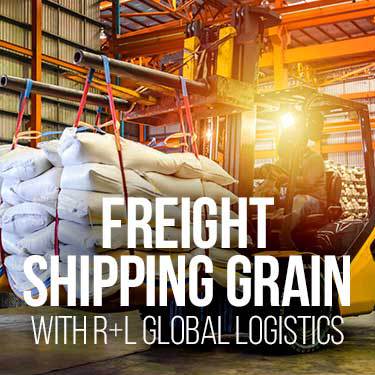
Now that you’re well-versed in how to start freight shipping grain, it’s time to reach out to R+L Global Logistics to get the process started. Our experienced team can give excellent care and service to your crops whether they’re heading to grocery stores, storage or to a processing plant.
Your grain will show up in great condition since we’ll ship it according to your specifications. This means it will be kept in a clean environment and show up to its destination nice and dry. We can pick it up from and ship it to any location within the United States. With R+L Global Logistics, you will also receive real-time freight visibility — so you know where your shipment of grain is at any time — and industry-best, around-the-clock customer service. Your delivery will also be there when you need it to be, by way of our on-time delivery rate of 99.5 percent that we take great pride in.
R+L Global Logistics can also assist you by offering expedited freight shipping during the instances where your grain has somewhere to be a bit faster than normal. With our group of experts, there’s not a load we can’t handle on your behalf. Our competitive freight rates will also make it easier to choose us as your partner and are just a part of the overall value proposition R+L Global Logistics can offer your business.
So when you’re ready to commence freight shipping grain, go with the best in the business at R+L Global Logistics. For a free quote, call us at 866.353.7178.
R+L Global Logistics
315 NE 14th St., Ocala, FL 34470